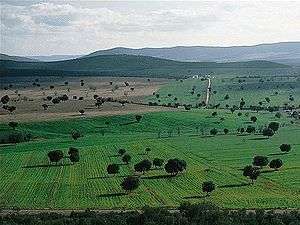Cabañeros National Park
| Cabañeros National Park | |
|---|---|
|
IUCN category II (national park) | |
|
A dehesa, traditional pastoral management in the park | |
 Location in Spain | |
| Location | Navas de Estena, Retuerta del Bullaque, Alcoba de los Montes, Horcajo de los Montes, Hontanar. |
| Nearest city | Toledo |
| Coordinates | 39°23′47″N 4°29′14″W / 39.39639°N 4.48722°WCoordinates: 39°23′47″N 4°29′14″W / 39.39639°N 4.48722°W |
| Area | 409 km² |
| Established | 20 November 1995 |
| Visitors | 75000 approx. (in 2007) |
| Governing body | Parques, (Spanish Ministry of Environment) |
Cabañeros National Park (in Spanish: Parque Nacional de Cabañeros) is a national park in the Montes de Toledo, Spain. It falls within two provinces, the northwest of Ciudad Real and the southwest of Toledo.
The Park was designated in 1995 and has an area of 390 square kilometres (150 sq mi).[1] It lies between the Estena and Bullaque rivers, extending into the Chorito and Miraflores mountain ranges.
It is the best and largest surviving area of Iberian Mediterranean forest, with an enormous variety of plant species. It also includes sites of geological interest (Paleozoic sites known as Cámbrico y Ordovícico del Parque Nacional de Cabañeros).[2]
As a curiosity, their exact antipodes coincide with Tongariro National Park, in New Zealand.[3]Tongariro National Park.
Fauna
The fauna of the park is notable, both for its variety (276 species of vertebrates) and for the high percentage of endangered species. Mammals include the otter in the Estena river and four species of ungulates: wild boar, red deer, roe deer and (in the most forested areas) fallow deer.[4]
The park is potentially a habitat for the Iberian lynx, a critically endangered feline. However, lynx have been sighted only intermittently in the area in recent years,[5] perhaps because of a shortage of rabbits, the main prey species.[6] The Toledo Mountains have been used as a site for the reintroduction of the lynx as part of a LIFE project.[7]
The Park is a Special Protection Area for birdlife,[8] and provides a home for the following notable species:
- Black stork (rare but not threatened)
- Eurasian black vulture (near threatened), second largest breeding population
- Spanish imperial eagle (threatened)
Conservation issues
In theory there is a ban on hunting at Cabañeros, as at other Spanish national parks. However, some hunting is allowed for purposes of "population control" (as opposed to sporting purposes).[9]
Notes
- ↑ Information about Cabañeros from Environment Ministry website, accessed April 2009 (Spanish)
- ↑ Gutiérrez-Marco, J.C.; García-Bellido, D.C.; Rábano, I.; Baeza Chico, E.; Sá, A.A. & Sarmiento, G.N. 2011. Geotouristic trails in the Cabañeros National Park (central Spain), pp. 125--128. In: Geotourism in Action. Proceedings of the International Congress of Geotourism–Arouca 2011, Arouca (Portugal).
- ↑ Recent dynamics of oak woodlands:a comparative ecological study at landscale scale R. Elena-Rosselló, M. Kelly; A. Martin; S. González_ävila; D. Sánchez de Ron; J.M. García del Barrio 02/2013; In book: Conservation and Management of Working Mediterranean Oak Woodland Ecosystems, Chapter: 14, Publisher: Springer Verlag, Editors: P. Campos-Palacín; L. Huntsinger, J.L. Oviedo
- ↑ http://www.parquenacionalcabaneros.com/fauna_elparque_60.html
- ↑ Pérez de Albéniz, Javier (2006) El Line Ibérico: Una batalla por la supervivencia. Lynx Ed., p.50
- ↑ "Cabañeros National Park begins habitat rehabilitation for the Lynx". Projecto Lynx. Retrieved 13 March 2015.
- ↑ "Iberlince releases eight new specimens of Iberian Lynx in "Montes de Toledo". Iberlince. 2014. Retrieved 13 March 2015.
- ↑ ["Archived copy". Archived from the original on 2007-07-10. Retrieved 2012-12-10./datazone/sitefactsheet.php?id=1714 "Important Bird Areas factsheet: Toledo mountains-Cabañeros"] Check
|url=value (help). BirdLife International. Downloaded from "Archived copy". Archived from the original on 2007-07-10. Retrieved 2012-12-10. on 11/01/2014 - ↑ Mendez, Rafael (2013). "El director de Parques Nacionales fue a una montería en la linde de Cabañeros". Retrieved 11 January 2014.
External links
| Wikimedia Commons has media related to Parque nacional de Cabañeros. |
